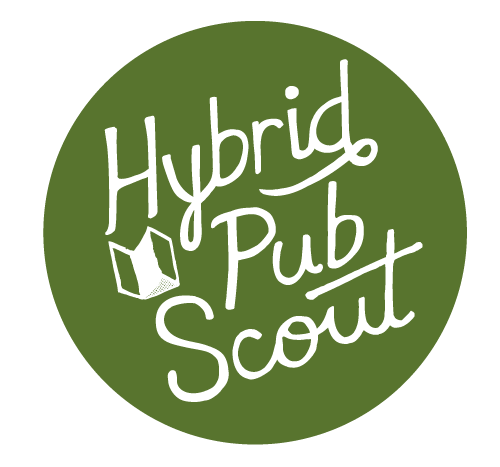Sure, writing can be a lonely pursuit. As someone who spends my days writing, I am alone most of the time. Sometimes I get so in my head that I accidentally run into household objects or forget what I’m talking about mid-sentence. If you spend a lot of time writing, you’ve got to get out of the house from time to time (and watch where you’re going).
One way to get out of your head as a writer is to acknowledge that, if you want your book to mean something to other people, you need feedback.
If you’ve been following Hybrid Pub Scout for any length of time, you won’t be surprised when I say writing and publishing a successful book is one of the most collaborative things you can do. You know that good publishing practice means bringing in competent editors, designers, and other guides.
But believe it or not, the dialogue between you, your book, and the rest of the world actually begins much sooner than the editing process. In fact, it begins before you even start writing.
In this blog (part one of four), I’m going to show you how to do research to write the book your audience needs and wants.
Find comp titles before you write your book
One of the most powerful lessons I took away from my conversation with Kelley Gardiner a couple weeks ago was the value of testing. She recommends starting your quest for feedback with a little bit (or a lotta-bit) of research on Amazon or other review sites.
Comp titles, aka., comparison titles, are books similar to the book that you want to publish. They’re beacons in a mystifying industry that help guide you to what catches readers’ attention. There’s a lot to say about the value of comp titles at every stage of your book’s development, but for now, start by doing the following on Amazon.
(Yes. Do it even if you hate Amazon and plan to sell elsewhere. Use their data to your advantage—it’s the least they can give you.)
Identify a High-Level Category
Let’s take this step by step. Start with the big picture—a high level category under which your book falls. Go to the drop-down menu at the top of the Amazon home page and type in your category.

The search will reveal the top books in that category. Copy-paste a few links for books that come up during that search into a doc so you can check them out later. If you want to get more specific, and I suggest you do, you’re not done.
Start with a top-selling book to scope out

Pick a book as a starting place. The top seller is fine, but anything in the top five or so should also be taken into account. I’m going to start by picking the third book from the left in this picture to examine, The Challenger Sale. It’s got the second highest number of reviews, and there isn’t a photo of the author on the cover—so it’s a better comp for someone who isn’t well-known on sight.
It is okay if you’ve never read any these books before. You’re just getting an idea of what’s out there. If you really want to read them later, cool. They’re now on your radar.
Scroll down to “Product Details” to find category options
Go all the way down the page—past the product description, book recommendations, and any editorial reviews. Product details will be useful in other areas of your book publishing journey, but for now, look under Best Sellers Rank to see where this book is ranking the best. It might surprise you to see where, but then, Amazon is always full of surprises, for better or worse. 😂😂😂

Investigate the bestsellers in those categories
When you click one of the blue links under the “Best Sellers Rank” heading, it will take you to the bestseller page for that category. You’ll see a grid with the top 100 bestselling books for it. Please note that in this picture, I’m looking at what sells best in the Kindle store. If you use a print book selection in your product search, there might be some variation in what categories and books come up. Look at both if you want, especially if you care about getting print sales.

Find comp titles and analyze their reviews
Whatever books or book descriptions appeal most to you or look the most like what you want to do, add it to the list. Once you’ve got a few, it’s time to start digging through reviews.
This time, scroll all the way down past the Product Details, past the About the Author section, and past the Sponsored Products carousels. Now start going through reviews. Five star reviews, one star reviews, all are worth checking out. Three or four stars can often be the most helpful of all. Those are the ones where people are likely to share what they felt was most helpful about the book and what they thought might be missing.
“Look at what the reviews are saying, not necessarily about the book, but what people wanted from the book… The questions that were answered, the questions that were left unanswered, what they wanted from it; what they got, what they didn’t get.”
Kelley Gardiner
Gauge audience interest—after you find out where they are
If you have a blog, podcast 😉, mailing list, or social media following, first ask yourself whether they are also the target audience for your book. Is your current audience curious about the topic you’re thinking of writing about? Try writing a blog on the topic or a post on your regular social media platforms and see what kind of response you get.
It’s like a minimum viable product, or an MVP, except the “P” here stands for…mmmm…point? Pontification? I think you get what I’m saying. Figure out whether the people already in your circles care about the topic enough to engage with it.
Use your comp titles to find your audience
Maybe you don’t have a huge following yet, or the audience you have isn’t quite the same as the one who is likely to want your book. In that case, take out that comp title list again. Get on the social media platform you use the most and start using the title and author names to find out what people are saying about those books. If you don’t see a ton of talk about it on your platform, maybe try another one. Check out who is reading those books. Think about whether they’re an audience you can connect with based on your book. Start thinking now about what you can do now to connect with these readers. Otherwise, when you publish, you’ll have a lovely, hard-won piece of work and nobody to sell it to.
Accept the gift of questions
Particularly if you’re a business owner, blogger, or another person who serves the public, you might already have a great entry point to your customer’s psyche.
“Questions are gold…for any kind of writer,” Kelley told me. “If your audience is asking you a question, then they’re giving you a huge gift. They’re telling you exactly what they want to know.”
If someone comes out to ask you about a topic within your area of expertise, write it down before you forget! If one person is curious about something, there’s a good chance other people are curious about it too. If you’re considering writing a book and you already have an audience that interacts with you, use their questions as launchpads to set a good trajectory for your project.
It’s okay if you’re not the first
Maybe something inside you wants to ignore all that advice.
Maybe you’re afraid that if you do your research, you’ll see something you don’t like. Specifically, you might see that someone else has written a book similar to yours, and maybe that someone has sold a lot of books. And, oh no, the author is so smart and successful! What are you even doing thinking you can do what they do?!
Even if you know that’s a silly train of thought, tell that to your sympathetic nervous system. That’s right. You can’t.
However, you can soothe that grumbling in the pit of your stomach by reminding yourself it’s usually a good thing to see book ideas similar to your own. That means there are people who want to pick up the sort of thing you’re about to throw down. Nobody out there will have the exact perspective you bring. Some people might be wired to understand the way you communicate better than the way other authors do. If you put research, love, and attention to detail into your book (and marketing—never forget marketing), there will be readers who will benefit.
So don’t give up before you even get started. As long as you’re not literally plagiarizing, your story is going to be unique.
Yes, it’s noisy out there. There are more books being published right now than at any other point in history, and that level of competition can make you want to retreat to the woods forever. Don’t let all the other voices out there keep you from sharing your story.
But before you start talking, keep your ears open. Be discerning of which voices you listen to, and then let them guide you into writing the best, most helpful book you possibly can.



